Related Research Articles

A kitchen is a room or part of a room used for cooking and food preparation in a dwelling or in a commercial establishment. A modern middle-class residential kitchen is typically equipped with a stove, a sink with hot and cold running water, a refrigerator, and worktops and kitchen cabinets arranged according to a modular design. Many households have a microwave oven, a dishwasher, and other electric appliances. The main functions of a kitchen are to store, prepare and cook food. The room or area may also be used for dining, entertaining and laundry. The design and construction of kitchens is a huge market all over the world.
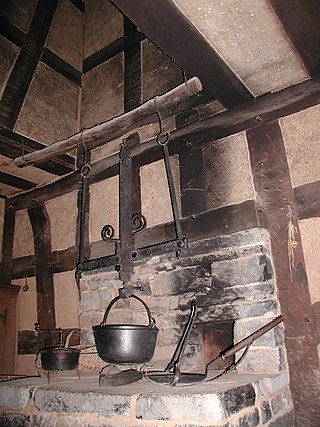
A hearth is the place in a home where a fire is or was traditionally kept for home heating and for cooking, usually constituted by at least a horizontal hearthstone and often enclosed to varying degrees by any combination of reredos, fireplace, oven, smoke hood, or chimney. Hearths are usually composed of masonry such as brick or stone. For millennia, the hearth was such an integral part of a home, usually its central and most important feature, that the concept has been generalized to refer to a homeplace or household, as in the terms "hearth and home" and "keep the home fires burning". In the modern era, since the advent of central heating, hearths are usually less central to most people's daily life because the heating of the home is instead done by a furnace or a heating stove, and cooking is instead done with a kitchen stove/range alongside other home appliances; thus many homes built in the 20th and 21st centuries do not have hearths. Nonetheless, many homes still have hearths, which still help serve the purposes of warmth, cooking, and comfort.

Colonel Sir Benjamin Thompson, Count Rumford, FRS, was an American-born British military officer, scientist, inventor and nobleman. Born in Woburn, Massachusetts, he supported the Loyalist cause during the American War of Independence, commanding the King's American Dragoons during the conflict. After the war ended in 1783, Thompson moved to London, where he was recognised for his administrative talents and received a knighthood from George III in 1784.

Cookware and bakeware is food preparation equipment, such as cooking pots, pans, baking sheets etc. used in kitchens. Cookware is used on a stove or range cooktop, while bakeware is used in an oven. Some utensils are considered both cookware and bakeware.

Outdoor cooking is the preparation of food in the outdoors. A significant body of techniques and specialized equipment exists for it, traditionally associated with nomad in cultures such as the Berbers of North Africa, the Arab Bedouins, the Plains Indians, pioneers in North America, and indigenous tribes in South America. These methods have been refined in modern times for use during recreational outdoor pursuits, by campers and backpackers.
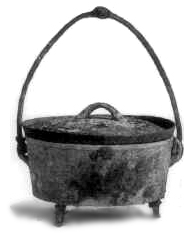
A Dutch oven, Dutch pot, or casserole dish (international) is a thick-walled cooking pot with a tight-fitting lid. Dutch ovens are usually made of seasoned cast iron; however, some Dutch ovens are instead made of cast aluminum, or ceramic. Some metal varieties are enameled rather than being seasoned, and these are sometimes called French ovens. The international name casserole dish is from the French casserole which means "cooking pot". They are similar to both the Japanese tetsunabe and the sač, a traditional Balkan cast-iron oven, and are related to the South African potjie, the Australian Bedourie oven and Spanish cazuela.

An oven is a tool that is used to expose materials to a hot environment. Ovens contain a hollow chamber and provide a means of heating the chamber in a controlled way. In use since antiquity, they have been used to accomplish a wide variety of tasks requiring controlled heating. Because they are used for a variety of purposes, there are many different types of ovens. These types differ depending on their intended purpose and based upon how they generate heat.
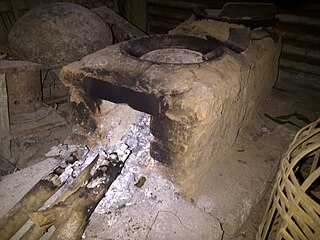
A stove or range is a device that generates heat inside or on top of the device, for -local heating or cooking. Stoves can be powered with many fuels, such as natural gas, electricity, gasoline, wood, and coal.

A kitchen stove, often called simply a stove or a cooker, is a kitchen appliance designed for the purpose of cooking food. Kitchen stoves rely on the application of direct heat for the cooking process and may also contain an oven, used for baking. "Cookstoves" are heated by burning wood or charcoal; "gas stoves" are heated by gas; and "electric stoves" by electricity. A stove with a built-in cooktop is also called a range.
A fireplace or hearth is a structure made of brick, stone or metal designed to contain a fire. Fireplaces are used for the relaxing ambiance they create and for heating a room. Modern fireplaces vary in heat efficiency, depending on the design.

Induction cooking is a cooking process using direct electrical induction heating of cooking vessels, rather than relying on indirect radiation, convection, or thermal conduction. Induction cooking allows high power and very rapid increases in temperature to be achieved: changes in heat settings are instantaneous.

A Rumford fireplace, sometimes known as a Rumford stove, is a tall, shallow fireplace designed by Sir Benjamin Thompson, Count Rumford, an Anglo-American physicist best known for his investigations of heat. Its shallow, angled sides are designed to reflect heat into the room, and its streamlined throat minimizes turbulence, thereby carrying away smoke with little loss of heated room air.

Heavy-duty cookware made of cast iron is valued for its heat retention, durability, ability to maintain high temperatures for longer time duration, and non-stick cooking when properly seasoned. Seasoning is also used to protect bare cast iron from rust. Types of cast-iron cookware include frying pans, dutch ovens, griddles, waffle irons, flattop grills, panini presses, crepe makers, deep fryers, tetsubin, woks, potjies, and karahi.

A cooktop, stovetop or hob, is a device commonly used for cooking that is commonly found in kitchens and used to apply heat to the base of pans or pots. Cooktops are often found integrated with an oven into a kitchen stove but may also be standalone devices. Cooktops are commonly powered by gas or electricity, although oil or other fuels are sometimes used.

A masonry heater is a device for warming an interior space through radiant heating, by capturing the heat from periodic burning of fuel, and then radiating the heat at a fairly constant temperature for a long period. Masonry heaters covered in tile are called Kachelofen. The technology has existed in different forms, from back into the Neoglacial and Neolithic periods. Archaeological digs have revealed excavations of ancient inhabitants utilizing hot smoke from fires in their subterranean dwellings, to radiate into the living spaces. These early forms eventually evolved into modern systems.
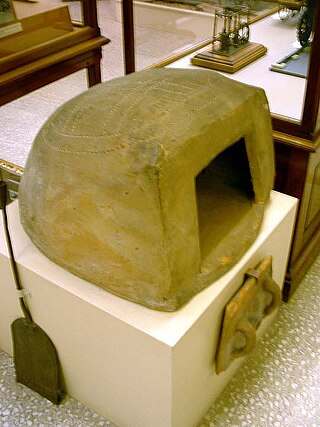
A clome oven is a type of masonry oven with a removable door made of clay or cast iron. It was a standard fitting for most kitchen fireplaces in Cornwall and Devon. The oven would be built into the side of the chimney breast, often appearing as a round bulge in the chimney. This bulge was the masonry surrounding the oven, and was intended to be dismantled should the oven ever need to be replaced. During installation, they are surrounded by packed clay to prevent the actual oven cracking.
The Chambers stove is a generic name for several different kitchen cooking appliances sold under the Chambers brand name from 1912 to approximately 1988. Their ranges and stand-alone ovens were known for their patented insulation methods, which enabled them to cook on retained heat with the fuel turned off.
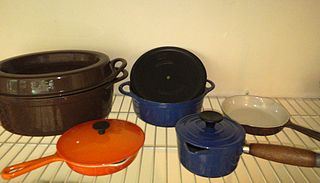
Cousances was a brand of enameled cast iron cookware. originally manufactured by a foundry in the town of Cousances-les-Forges in northeastern France. The Cousances foundry began making cast iron pans in 1553. Four centuries later, in 1957, the brand was acquired by Le Creuset. Cookware under the Cousances brand continued to be manufactured by Le Creuset into the early 1980s.
Metal Ware Corporation is a company located in Two Rivers, Wisconsin and manufactures small kitchen appliances primarily marketing them under the NESCO and American Harvest brand names.
References
- ↑ https://streetsofsalem.com/2013/02/01/rumford-roasters/
- 1 2 Radocchia, Jane Griswold. "Rumford Roasters" . Retrieved 2 December 2024.
- ↑ Blake, Anthony; Crewe, Quentin (1978). Great Chefs of France: The Masters of Haute Cuisine and Their Secrets. H. N. Abrams. pp. 20–21. ISBN 978-0-8317-3961-4.
- 1 2 3 Ferry, John H. (2001). "Food for Thought: A View Toward a Richer Interpretation of the House Museum Kitchen" (PDF). CRM: Cultural Resource Management. 24 (4). Retrieved 2 December 2024.
- 1 2 3 "Rundlet-May House - Front Kitchen" . Retrieved 2 December 2024.
- ↑ "Rundlet-May House - Rumford Roaster" . Retrieved 2 December 2024.
- ↑ Reber, Patricia Bixler (1999). "Iron wall ovens". www.angelfire.com. Retrieved 2 December 2024.
- ↑ "Researching Food History : Rumford Roaster - never before seen pieces". Researching Food History. 17 February 2020. Retrieved 2 December 2024.
- ↑ "Ellen Swallow Richards: Rumford Kitchen: Institute Archives & Special Collections: MIT". web.archive.org. 13 April 2003. Archived from the original on 13 April 2003.
- ↑ "The Remond Family". Hamilton Hall. Retrieved 2 December 2024.